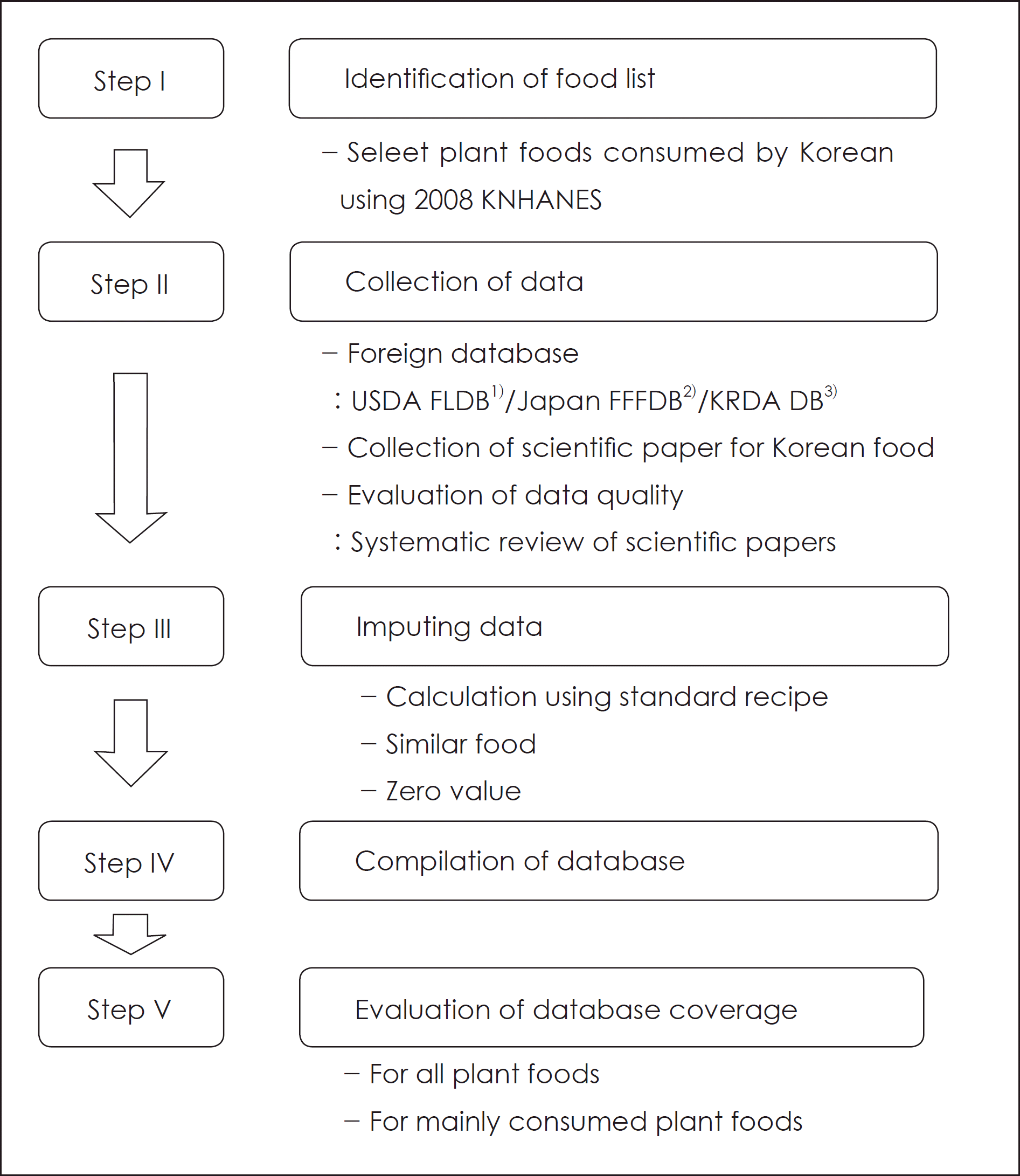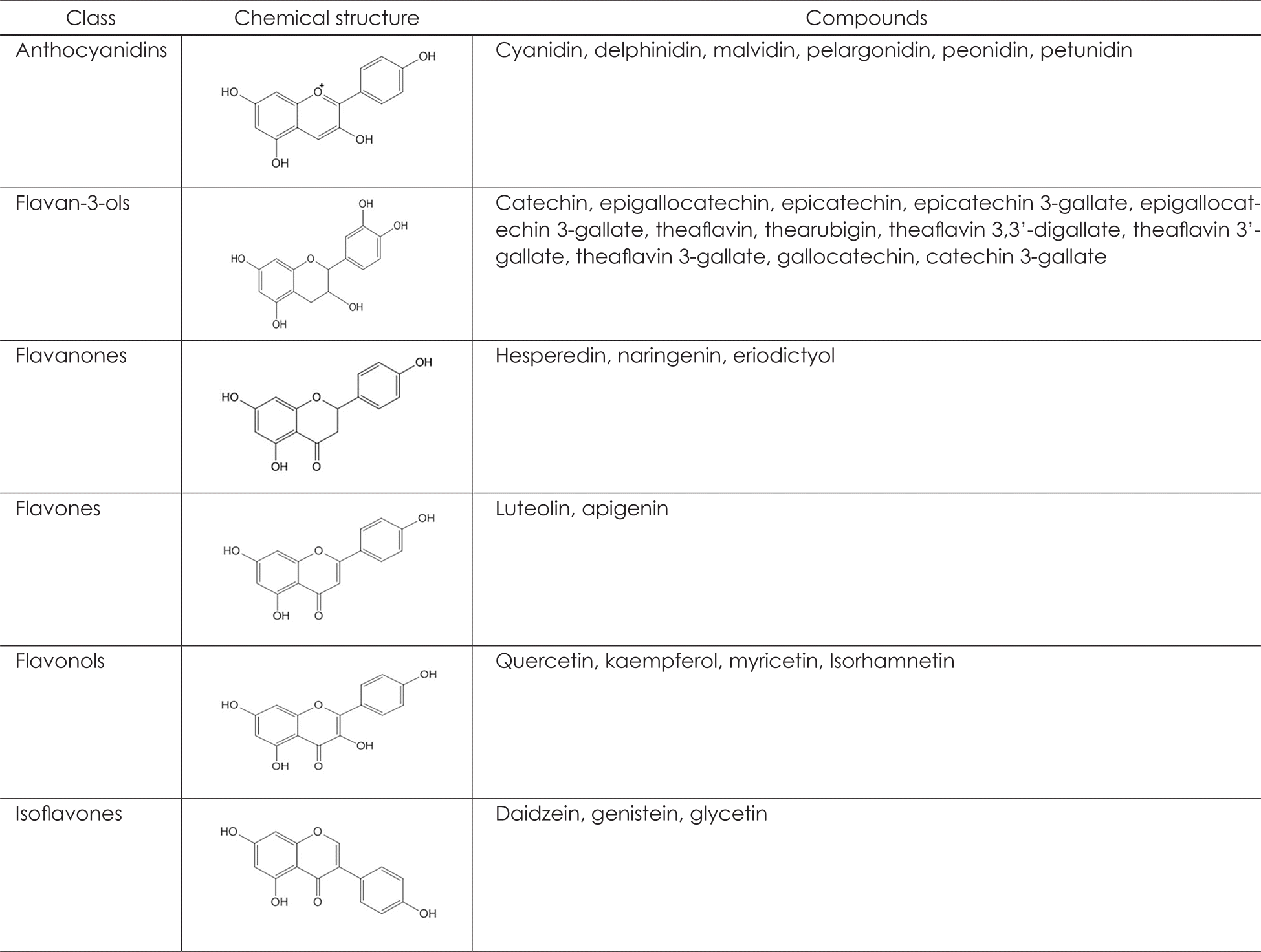Abstract
Flavonoids have been hypothesized to reduce the risk of chronic diseases, but the lack of a flavonoid database hampered epidemiological studies addressing this issue in Korea. In this study, we developed a flavonoid database, based on a systematic review. A total of 1549 food items containing flavonoids were selected using the Korean Nutrient Database. Among them, flavonoid contents for only 649 food items were evaluated with analytical values and the remaining 900 items were replaced with adaptations or calculations from similar items. The developed flavonoid database covered 93.2% of fruits and fruit juices, 76.1% of vegetables, 98.4% of legumes and legume products, and 85.0% of all plant foods overall (1,549 items) as reported by the 24-hr dietary recall method regarding the 2008 Korean National Health and Nutrition Examination Survey. We found that this flavonoid database, overall, included 95.6% of all mainly consumed plant foods by Koreans. This flavonoid database is expected to be useful in regards to the correlation study of flavonoid intake and chronic diseases.
Go to : 
REFERENCES
1). Doll R. An overview of the epidemiological evidence linking diet and cancer. Proc Nutr Soc. 1990; 49(2):119–131.

2). Perez-Vizcaino F, Duarte J. Flavonols and cardiovascular disease. Mol Aspects Med. 2010; 31(6):478–494.

3). Knekt P, Kumpulainen J, Järvinen R, Rissanen H, Heliövaara M, Reunanen A, Hakulinen T, Aromaa A. Flavonoid intake and risk of chronic diseases. Am J Clin Nutr. 2002; 76(3):560–568.

4). Kim JY, Kwon O. Culinary plants and their potential impact on metabolic overload. Ann NY Acad Sci. 2011; 1229:133–139.

5). Holden JM, Bhagwat SA, Haytowitz DB, Gebhardt SE, Dwyer JT, Peterson J, Beecher GR, Eldridge AL, Balentine D. Development of a database of critically evaluated flavonoids data: application of USDA’s data quality evaluation system. J Food Compost Anal. 2005; 18(8):829–844.

6). Dwyer JT, Peterson JJ. Measuring flavonoid intake: need for advanced tools. Public Health Nutr. 2002; 5(6A):925–930.

7). Hollman PC, Bijsman MN, van Gameren Y, Cnossen EP, de Vries JH, Katan MB. The sugar moiety is a major determinant of the absorption of dietary flavonoid glycosides in man. Free Radic Res. 1999; 31(6):569–573.

8). Rice-Evans C, Spencer JP, Schroeter H, Rechner AR. Bioavail-ability of flavonoids and potential bioactive forms in vivo. Drug Metabol Drug Interact. 2000; 17(1-4):291–310.

9). Rice-Evans CA, Miller NJ, Bolwell PG, Bramley PM, Pridham JB. The relative antioxidant activities of plant-derived polyphe-nolic flavonoids. Free Radic Res. 1995; 22(4):375–383.

10). Formica JV, Regelson W. Review of the biology of Quercetin and related bioflavonoids. Food Chem Toxicol. 1995; 33(12):1061–1080.

11). Rauha JP, Remes S, Heinonen M, Hopia A, Kähkönen M, Kujala T, Pihlaja K, Vuorela H, Vuorela P. Antimicrobial effects of Finnish plant extracts containing flavonoids and other phenolic compounds. Int J Food Microbiol. 2000; 56(1):3–12.

12). Erdman JW Jr, Balentine D, Arab L, Beecher G, Dwyer JT, Folts J, Harnly J, Hollman P, Keen CL, Mazza G, Messina M, Scalbert A, Vita J, Williamson G, Burrowes J. Flavonoids and heart health: proceedings of the ILSI North America Flavonoids Workshop, May 31-June 1, 2005, Washington, DC. J Nutr. 2007; 137(3 Suppl 1):718S–737S.

13). Chun OK, Chung SJ, Song WO. Estimated dietary flavonoid intake and major food sources of U.S. adults. J Nutr. 2007; 137(5):1244–1252.

14). U.S. Department of Agriculture, Agricultural Research Service. USDA database for the flavonoid content of selected foods, Release 2.1. 2007 Jan [cited 2011 Aug 1]. Available from. http://www.ars.usda.gov/SP2UserFiles/Place/12354500/Data/Flav/Flav02-1.pdf.
15). U.S. Department of Agriculture, Agricultural Research Service. USDA database for the isoflavone content of selected foods, Release 2.0. 2008 Sep. [cited 2012 Feb 23]. Available from. http://www.ars.usda.gov/SP2UserFiles/Place/12354500/Data/isoflav/Isoflav_R2.pdf.
16). National Institute of Health and Nutrition in Japan. Functional food factor. 2008 [cited 2011 Jun 1]. Available from. http://www.nih.go.jp/.
17). National Academy of Agricultural Science. Tables of food functional composition. 1st edition.Suwon: Rural Development Administration;2009.
18). National Rural Resources Development Institute. Food composition table. 7th edition.Suwon: Rural Development Administration;2006.
19). Mangels AR, Holden JM, Beecher GR, Forman MR, Lanza E. Carotenoid content of fruits and vegetables: an evaluation of analytic data. J Am Diet Assoc. 1993; 93(3):284–296.

20). Ministry of Health and Welfare. Construction of a Database for Nutritive Components of foods. Seoul. 2000.
21). Holden JM, Eldridge AL, Beecher GR, Buzzard M, Bhagwat S, Davis CS, Douglass LW, Gebhardt S, Haytowitz D, Schakel S. Carotenoid content of U.S. foods: an update of the database. J Food Compost Anal. 1999; 12(3):169–196.

22). Zamora-Ros R, Andres-Lacueva C, Lamuela-Raventós RM, Berenguer T, Jakszyn P, Barricarte A, Ardanaz E, Amiano P, Dorronsoro M, Larrañaga N, Martínez C, Sánchez MJ, Navarro C, Chirlaque MD, Tormo MJ, Quirós JR, González CA. Estimation of dietary sources and flavonoid intake in a Spanish adult population (EPIC-Spain). J Am Diet Assoc. 2010; 110(3):390–398.

23). Sievert YA, Schakel SF, Buzzard IM. Maintenance of a nutrient database for clinical trials. Control Clin Trials. 1989; 10(4):416–425.

24). Schakel SF, Sievert YA, Buzzard IM. Sources of data for developing and maintaining a nutrient database. J Am Diet Assoc. 1988; 88(10):1268–1271.

25). Holden JM, Bhagwat SA, Patterson KY. Development of a multi-nutrient data quality evaluation system. J Food Compost Anal. 2002; 15(4):339–348.

26). Hollman PC, de Vries JH, van Leeuwen SD, Mengelers MJ, Katan MB. Absorption of dietary quercetin glycosides and quercetin in healthy ileostomy volunteers. Am J Clin Nutr. 1995; 62(6):1276–1282.

27). Kim JS, Yoon S. Isoflavone contents and beta-glucosidase activities of soybeans, meju and doenjang. Korean J Food Sci Technol. 1999; 31(6):1405–1409.
28). Jang CH, Park CS, Lim JK, Kim JH, Kwon DY, Kim YS, Shin DH, Kim JS. Metabolism of isoflavone derivatives during manufacturing of traditional meju and doenjang. Food Sci Biotechnol. 2008; 17(2):442–445.
29). Moon BK, Jeon KS, Hwang IK. Isoflavone contents in some varieties of soybean and on processing conditions. Korean J Soc Food Sci. 1996; 12(4):527–534.
30). Kim JS, Lee YS, Kim JS, Hahn Y. High performance liquid chromatographic analysis of isoflavones in soybean foods. Korean J Food Sci Technol. 2000; 32(1):25–30.
31). Choi HB, Sohn HS. Isoflavone content in Korean fermented and unfermented soybean foods. Korean J Food Sci Technol. 1998; 30(4):745–750.
Go to : 
 | Fig. 1.Overall flow of development of flavonoid database. 1) USDA flavonoid database 2) Japan functional food factor database 3) Korean RDA: Food functional composition table. |
Table 2.
Database sources of composition of flavonoids
| Categories | No. of food items | Percentage (%) | |
|---|---|---|---|
| Analytical values | USDA Flavonoid DB 1) | 545 | 35.2 |
| Japan FFF DB 2) | 030 | 1.9 | |
| Korea RDA FFCT3) | 002 | 0.1 | |
| Literature review | 072 | 4.6 | |
| Imputing values | Calculation of moisture | 082 | 5.3 |
| Calculation of recipe | 073 | 4.7 | |
| Similar food | 309 | 20.0 | |
| Zero value | 204 | 13.2 | |
| Missing value | 232 | 15.0 | |
| Total | 1,549 | 100.0 |
Table 3.
Worksheet for isoflavones in Doenjang (Soybean paste)
| Refa | Data quality criteria ratings | Quality indexb | Isoflavone value (mg/100 g) | ||||||||
|---|---|---|---|---|---|---|---|---|---|---|---|
| No.of samples | Analytic method | Sample handling | Sampling plan | Quality control | Daidzein | Genistein | Glycitein | Total Isoflavones | |||
| Actual no. | Rating | ||||||||||
| Kim, 199927) | 1 | 1 | 1 | 2 | 1 | 0 | 10 | 24.75c | 24.75 | 49.50 | |
| Jang, 200828) | 1 | 1 | 1 | 2 | 1 | 1 | 1.2 | 27.30 | 30.20 | 7.9 | 66.00 |
| Moon, 199629) | 4 | 2 | 1 | 2 | 1 | 0 | 1.2 | 01.50 | 00.88 | 02.38 | |
| Kim, 200030) | 1 | 1 | 1 | 2 | 1 | 1 | 1.2 | 15.19 | 04.41 | 19.60 | |
| Choi, 199831) | 4 | 2 | 1 | 2 | 1 | 0 | 1.2 | 13.57 | 15.32 | 28.84 | |
| Mean | 16.46 | 15.11 | 7.9 | 33.26 | |||||||
| Summary: Quality Sumd = 5.8; Confidence Codee = B | |||||||||||
Table 4.
Assessment of database coverage
Table 5.
Key foods with appreciable amounts of flavonoids
| Food description | Compounds with appreciable amounts (mg/100 g) |
|---|---|
| Soybeans, dried 1) | Daidzein (78.86), Genistein (89.32), Glycetin (18.76) |
| Tofu, Soybean curd 1) | Daidzein (12.31), Genistein (16.10), Glycetin (2.75) |
| Soybean sprout, raw 1) | Daidzein (12.86), Genistein (18.77), Glycetin (2.88) |
| 1) Radishes, raw | Pelargonidin (25.66), Kaempferol (0.86), |
| Onion, raw 1) | Apigenin (0.01), Luteolin (0.01), Isorhamnetin (5.01), Kaempferol (0.62), Myricetin (0.02), Quercetin (21.42) |
| Kimchi, Baechu 3) | Luteolin (0.23), Kaempferol (0.74), Myricetin (0.02), Quercetin (0.09) |
| Kimchi, Yeolmu 3) | Luteolin (0.09), Kaempferol (7.12), Quercetin (55.72) |
| Persimmon, raw 1)4) | Cyanidin (45.32), Catechin (0.63), Gallocatechin (0.17) |
| 1) Pear, raw | Cyanidin (12.18), Catechin (0.27), Epigallocatechin (0.59), Epicatechin (3.76), Epicatechin 3-gallate (0.02), Epigallocatechin 3-gallate (0.17), Isorhamnetin (0.30), Quercetin (4.51) |
| Citrus fruit, Satsuma mandarin 1) | Hesperetin (7.94), Naringenin (10.02) |
| Apple, fuji, raw 1) | Cyanidin (0.76), Delphinidin (0.01), Pelargonidin (0.01), Catechin (0.70), Epigallocatechin (1.14), Epicatechin (5.21), Epigallocatechin 3-gallate (1.93), Quercetin (2.02) |
| Green tea, dried 1) | Catechin (57.12), Epigallocatechin (2057.98), Epicatechin (811.72), Epicatechin 3-gallate (1491.29), Epigallocatechin 3-gallate (7115.98), Theaflavin (1.64), Thearubigin (131.91), Gallocatechin (258.11), Catechin 3-gallate (7.07), Apigenin (12.03), Luteolin (0.17), Kaempferol (147.55), Myricetin (104.76), Quercetin (223.97) |
| Doenjang, soybean paste 2) | Daidzein (16.46), Genistein (15.11), Glycetin (7.90) |
| Chunggukjang, fermented soybean 2) | Daidzein (61.40), Genistein (90.28), Glycetin (19.3) |
| Ganjang, soy sauce, Korean 2) | Daidzein (0.15), Genistein (0.22), Glycetin (0.00) |
Table 6.
Food list with missing value among the mainly consumed plant foods




 PDF
PDF ePub
ePub Citation
Citation Print
Print



 XML Download
XML Download